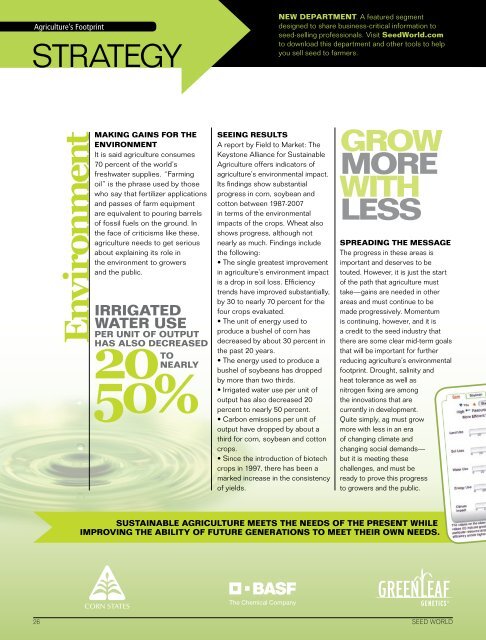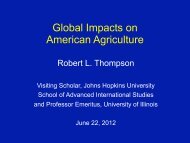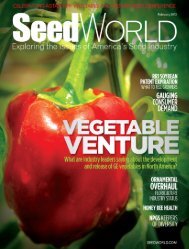Wet Chemistry Soybean Series - Seed World
Wet Chemistry Soybean Series - Seed World
Wet Chemistry Soybean Series - Seed World
- No tags were found...
You also want an ePaper? Increase the reach of your titles
YUMPU automatically turns print PDFs into web optimized ePapers that Google loves.
Agriculture’s FootprintstrategyNEW DEPARTMENT. A featured segmentdesigned to share business-critical information toseed-selling professionals. Visit <strong>Seed</strong><strong>World</strong>.comto download this department and other tools to helpyou sell seed to farmers.EnvironmentMaking Gains for theEnvironmentIt is said agriculture consumes70 percent of the world’sfreshwater supplies. “Farmingoil” is the phrase used by thosewho say that fertilizer applicationsand passes of farm equipmentare equivalent to pouring barrelsof fossil fuels on the ground. Inthe face of criticisms like these,agriculture needs to get seriousabout explaining its role inthe environment to growersand the public.Irrigatedwater use2050%toper unit of outputhas also decreasednearlySeeing ResultsA report by Field to Market: TheKeystone Alliance for SustainableAgriculture offers indicators ofagriculture’s environmental impact.Its findings show substantialprogress in corn, soybean andcotton between 1987-2007in terms of the environmentalimpacts of the crops. Wheat alsoshows progress, although notnearly as much. Findings includethe following:• The single greatest improvementin agriculture’s environment impactis a drop in soil loss. Efficiencytrends have improved substantially,by 30 to nearly 70 percent for thefour crops evaluated.• The unit of energy used toproduce a bushel of corn hasdecreased by about 30 percent inthe past 20 years.• The energy used to produce abushel of soybeans has droppedby more than two thirds.• Irrigated water use per unit ofoutput has also decreased 20percent to nearly 50 percent.• Carbon emissions per unit ofoutput have dropped by about athird for corn, soybean and cottoncrops.• Since the introduction of biotechcrops in 1997, there has been amarked increase in the consistencyof yields.GROWMOREWITHLESSSpreading the MessageThe progress in these areas isimportant and deserves to betouted. However, it is just the startof the path that agriculture musttake—gains are needed in otherareas and must continue to bemade progressively. Momentumis continuing, however, and it isa credit to the seed industry thatthere are some clear mid-term goalsthat will be important for furtherreducing agriculture’s environmentalfootprint. Drought, salinity andheat tolerance as well asnitrogen fixing are amongthe innovations that arecurrently in development.Quite simply, ag must growmore with less in an eraof changing climate andchanging social demands—but it is meeting thesechallenges, and must beready to prove this progressto growers and the public.Sustainable agriculture meets the needs of the present whileimproving the ability of future generations to meet their own neeDS.26 <strong>Seed</strong> <strong>World</strong>






